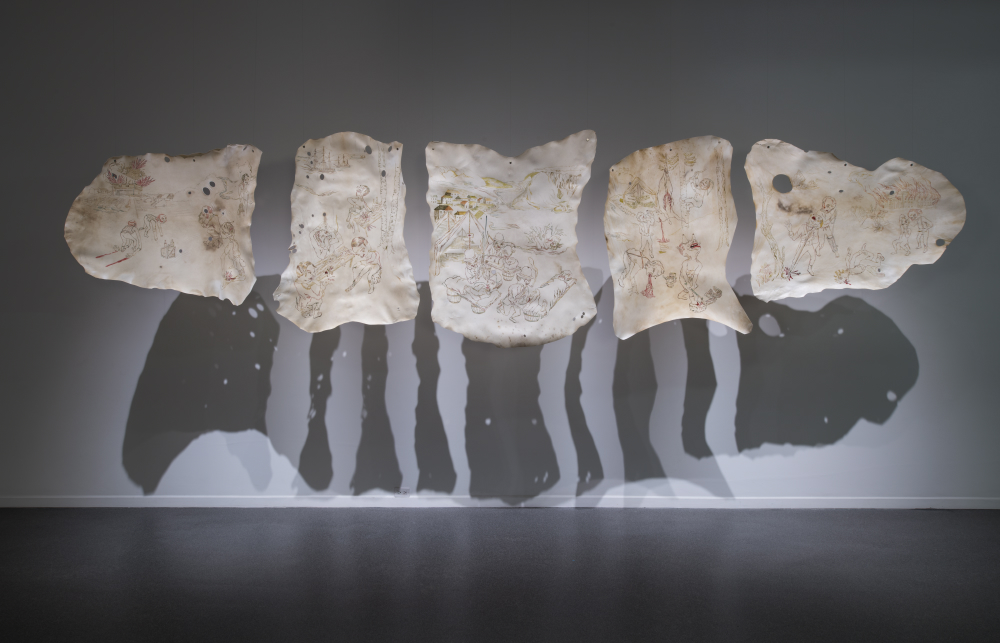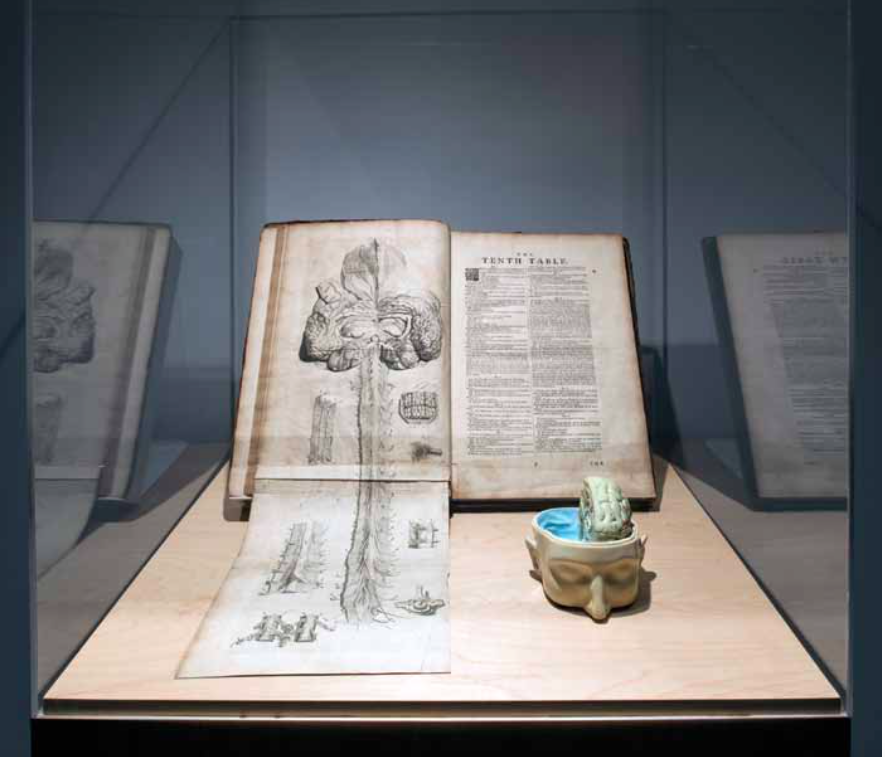
Howie Tsui, “Of Malingerers, Skulkers and Dupes,” 2012. Acrylic ink on deerskin parchment. Collection of the Artist.
While exploring Anatomica, I experienced several moments of disorientation, unsure whether I was approaching a piece with stronger connections to an artists’ studio or a laboratory. Take the human spine curving from a steel frame in the gallery. From a distance, artist Sarah Maloney’s Vertebrae, Sacrum, Coccyx looks like a replica meant to be studied by medical students, while up close, the unexpected is revealed: each vertebra has been realistically hand-knitted, stitches multiplying like cells. These split seconds of uncertainty gave the exhibit an adventurous sense of mystery.
By combining contemporary artworks with medical artifacts, Anatomica—on view January 16 – March 8 at Dalhousie Art Gallery—set up a complex dialogue about the human body and its representations, allowing “a curiosity to emerge, and for new sets of questions to be asked of the materials on display,” as Ottawa-based curator Cindy Stelmackowich describes. A pink knitted brain, also by Maloney, rests near a plastic classroom model of the same organ. I wondered if Maloney’s soft, anatomically correct folds of cerebral cortex might make the more inviting teaching tool. Stelmackowich’s own recent artworks find inspiration in vintage microscopic slides—which is fitting given she completed a Post-Doctoral Fellowship at Dalhousie that focused on the relation between science, knowledge, and representation. The exhibition included rare materials from Dalhousie University’s Killam Library Special Collections and its Division of Anatomy within the

William Cowper, The Anatomy of Humane Bones, 1737
(Dalhousie University Killam Library, Special Collections) and Anatomical Model: Brain, 1960s (Division of Anatomy – Department of Medical Neuroscience, Dalhousie University).
Department of Medical Neuroscience, such as anatomical atlases, engravings and diagrams. Seeing these items in a gallery setting highlighted their artistry and idiosyncrasies, while showing that our understanding of human anatomy has not been static over time. The viewer is led to “ask how aesthetics, imagination and creativity have always informed the making of medical representations and medical teaching tools,” Stelmackowich says.
“Normally, these types of questions are not asked of this material, as they are understood as laying down the ‘rules’ of the medical gaze.” The artworks in Anatomica were presented as the products of unique imaginings, while still connected to their scientific origins. These pieces converse directly with “the histories and medical traditions to which the artists’ imagery and sources of inspiration belong,” Stelmackowich explains. “The contemporary artworks bring new narratives, new materials, new psychologies, new logics and new ways of seeing to the standard yet complex biomedical gaze.”
One of the ways Anatomica complicated the textbook view of anatomy was by highlighting different materials and textures. Lyn Carter conjures the lungs and heart as sewn three dimensional forms, where fabric becomes skin and buttoned up collars suggest composure and concealment. At the same time, the design on the chintz fabric of the lungs is reminiscent of veins—maybe the heart is being worn on the sleeve, the interior made exterior, after all.
Patterns recur and repeat, in nature and in art. Lisa Nilsson creates models of cross-sections of human tissue by paper quilling, which involves rolling and shaping narrow strips of Japanese mulberry paper. The density and detail of her re-creations is breathtaking. Maskull Lasserre also works with paper and sculpture in his work Lexicon, where he has carved a human spine and ribcage into a stack of newspapers, which are squeezed together in a mechanical press and continuously disintegrating. Nilsson, Maloney and Carter’s processes, in particular, ask us to consider the relation of crafting practices to fine art, the gendered body and how it has been represented in medicine and in art, and the traditionally labour-intensive, yet invisible quality of so-called women’s work.
Human anatomy is laid bare as both beautiful and grotesque. Maura Doyle’s Bone Dump features 8,000 hand sculpted porcelain femur bones, which are quite lovely in their individual delicacy, but disturbing as a whole, their piled form bringing to mind a mass grave. Musketball! is a working pinball machine, repurposed by Howie Tsui to depict a British soldier reeling from a musket shot, his guts exploding while the pinball bounces off a background of graphically drawn innards, the words ‘mangled viscera’ decorating the ribs. Tsui contrasts the game’s whimsy with the violence and repetition of combat. Meanwhile, a human skull from the 1930s, a frighteningly archaic-looking surgical kit and casts of fetal lungs and blood supply are eerie in their realness.
Whether dissecting or synthesizing, clinical or playful or reverent, Anatomica provided us with an uncommon window into interior physical landscapes.














Leave a Reply